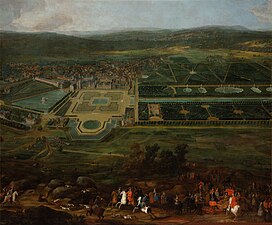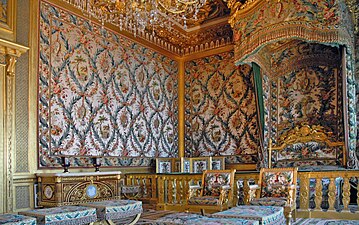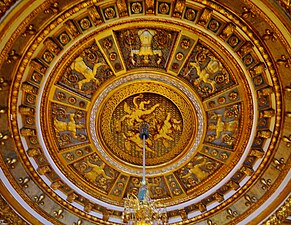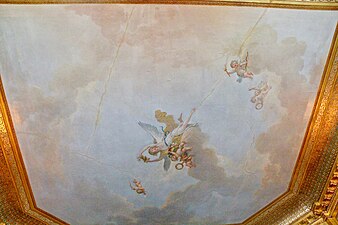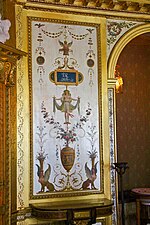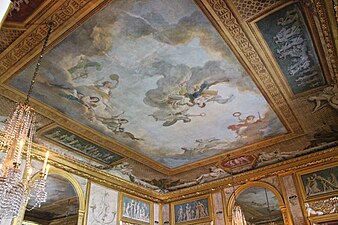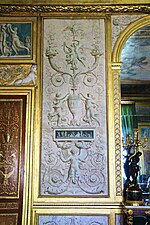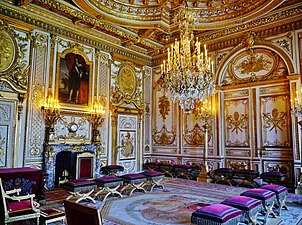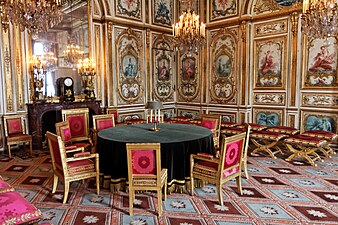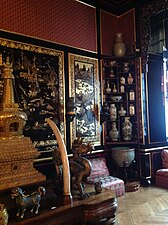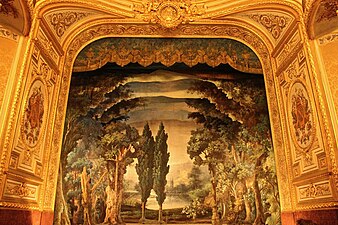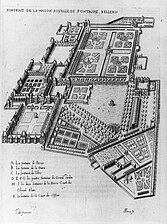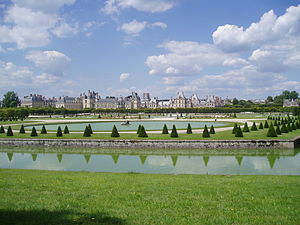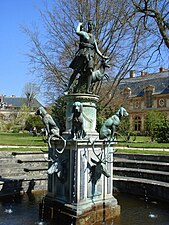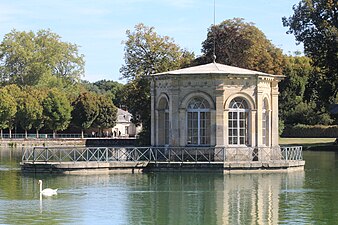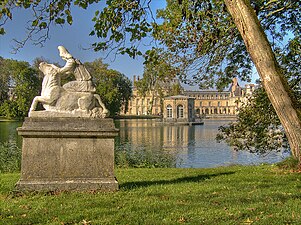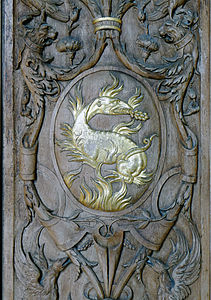Palace of Fontainebleau
| Palace of Fontainebleau | |
|---|---|
 Château de Fontainebleau | |
 Interactive fullscreen map | |
| Location | Fontainebleau, Seine-et-Marne, France |
| Coordinates | 48°24′8″N 2°42′2″E / 48.40222°N 2.70056°E |
Europe and North America | |
Palace of Fontainebleau (
History
Name

"Fontainebleau" took its name from the "Fontaine Belle-Eau", a natural fresh water spring located in the English garden not far from the chateau. The name means "Spring of beautiful water". In the 19th century the spring was rebuilt with an octagonal stone basin, as it appears today.[5]
Hunting Lodge and castle (12th century)
The earliest reference to a royal residence at Fontainebleau dates to 1137 under King
The first chateau was a square "donjon" or keep, a fortified tower surrounded by a wall. It was three stories high, and occupied an area of about fifty square meters. The lower walls were three meters wide, while the upper walls were a meter wide, and had windows facing north and south The King resided on the middle level. The stone wall was topped by. wooden palisade. The original tower, rebuilt to fit the later styles, is still part of the Oval Court. [7]
Francis I and The first School of Fontainbleau (1528–1547)

The modest medieval castle remained until the reign of Francis I of France (1494–1547). The King commissioned the architect Gilles Le Breton to build a new palace in the Renaissance style. Le Breton created the Cour Ovale, or oval courtyard, He preserved the original medieval keep on one side, but added a monumental new building, the Porte Dorée or Golden Gate, in the Italian Renaissance style, as the main entry of the Palace, On the north side he built another building with a Renaissance stairway, the Portique de Serlio, which gave access the royal apartments.[9]
Beginning in about 1528, Francis constructed the Galerie François I, which allowed him to pass directly from his apartments to the chapel of the Trinitaires. He brought the architect Sebastiano Serlio from Italy, and the Florentine painter Giovanni Battista di Jacopo, known as Rosso Fiorentino, to decorate the new gallery. Between 1533 and 1539 Rosso Fiorentino filled the gallery with murals glorifying the king, framed in stucco ornament in high relief, and lambris sculpted by the furniture maker Francesco Scibec da Carpi. Another Italian painter, Francesco Primaticcio from Bologna ("Primatice" to the French), joined later in the decoration of the gallery. Their elaborate mixture of painting and sculpture became known as the first School of Fontainebleau, which helped launch the French Renaissance.[10] The emblem of Francis,I a salamander surrounded by flames, is found alongside each painting he commissioned in the Grand Gallery.[11]
In about 1540, Francis began another major addition to the chateau. Using land on the east side of the chateau purchased from the order of the Trinitaires, he began to build a new square of buildings around a large courtyard. It was enclosed on the north by the wing of the Ministers, on the east by the wing of Ferrare, and on the south by a wing containing the new gallery of Ulysses. The chateau was surrounded by a new park in the style of the Italian Renaissance garden, with pavilions and the first grotto in France. Primaticcio created more monumental murals for the gallery of Ulysses.[10]
Henry II and Catherine de' Medici (1547–1570)

Following the death of Francis I, King
Their major project was the Oval Court, which was designed to be the entrance to the new royal apartments. They transformed the loggia originally planned by Francois into a Salle des Fêtes, or grand ballroom, with a coffered ceiling. Facing the courtyard of the fountain and the fish pond.
The decoration of the new ballroom featured murals by Francesco Primaticcio, surrounded by elaborate stucco sculpture. A new generation of artists joined the work, including the Mannerists painters Primaticcio and Niccolò dell'Abbate.[12] It was also the birth locale of Francis II of France, King Henry II's firstborn son.
Following the death of Henry II in a jousting accident, his widow, Catherine de' Medici, took over the project, which she carried out through the reigns of her three sons,Francis II, Charles IX, and Henry III. decoration of the château. She named Primaticcio as the new superintendent of royal public works. He designed the section known today as the wing of the Belle Cheminée, noted for its elaborate chimneys and its two opposing stairways. In 1565, as a security measure due to the Wars of Religion, she also had a moat dug around the château to protect it against attack.[12]
Henry IV (1570–1610)

King Henry IV made more additions to the château than any king since Francis I. He extended the oval court toward the west by building two pavilions, called Tiber and Luxembourg. Between 1601 and 1606, he remade all the façades around the courtyard, including that of the chapel of Saint-Saturnin, to give the architecture greater harmony. On the east side, he built a new monumental domed gateway, the Porte du Baptistère. Between 1606 and 1609, he built a new courtyard, the Cour des Offices or Quartier Henry IV, to provide a place for the kitchens and residences for court officials. Two new galleries, the Galerie de Diane de Poitiers and the Galerie des Cerfs, were built to enclose the old garden of Diane. He also added a large jeu de paume, or indoor tennis court, the largest such court existing in the world.[13][14][15]
A second School of Fontainebleau group of painters and decorators went to work on the interiors. The architect Martin Fréminet created the ornate chapel of the Trinity, while the painters Ambroise Dubois and Toussaint Dubreuil created a series of heroic paintings for the salons. A new wing, named for its central building, La Belle Cheminée, was built next to the large fish pond.
Henry IV also devoted great attention to the park and gardens around the chateau. The garden of the Queen or garden of Diane, created by Catherine de' Medici, with the fountain of Diane in the center, was located on the north side of the palace. Henry IV's gardener,
Louis XIII to Louis XVI (17th-18th century)
-
Fountain and garden behind the Chateau (about 1680)
-
Louis XIV hunting near the Palace of Fontainebleau. Painting by Pierre-Denis Martin (1718-1723)
-
Court of Fountains (1755)
King Louis XIII, who had been born and baptized in the Château, continued the works begun by his father. He completed the decoration of the chapel of the Trinity, and assigned the court architect Jean Androuet du Cerceau to reconstruct the horseshoe stairway earlier designed by Philibert Delorme on the courtyard that had become known as the Cour de Cheval Blanc. After his death, his widow, Anne of Austria, redecorated the apartments within the Wing of the Queen Mothers (Aile des Reines Mères) next to the Court of the Fountain, designed by Primatrice.[16]
King
Louis XIV welcomed many foreign guests there, including the former Queen
On May 19–20, 1717, during the Regency following the death of Louis XIV, the Russian Tsar Peter the Great was a guest at Fontainebleau. A hunt for stags was organized for him, and a banquet. Officially the visit was a great success, but in the memoirs published later by members of the delegation, it appears that Peter disliked the French style of hunting, and that he found the Château too small, compared with the other royal French residences. The routine of Fontainebleau also did not suit his tastes; he preferred beer to wine (and brought his own supply with him) and he liked to get up early, unlike the French Court.[17][18]
The renovation projects of Louis XV were more ambitious than those of Louis XIV. To create more lodging for his enormous number of courtiers, in 1737–38 the King built a new courtyard, called the Cour de la Conciergerie or the Cour des Princes, to the east of the Galerie des Cerfs. On the Cour du Cheval Blanc, the wing of the Gallery of Ulysses was torn down and gradually replaced by a new brick and stone building, built in stages in 1738–1741 and 1773–74, extending west toward the Pavilion and grotto of the pines.
Between 1750 and 1754, the King commissioned the architect
King
The Revolution and the First Empire
-
Napoleon signs his abdication at Fontainebleau on 4 April 1814
-
Napoleon saying farewell to his Old Guard in the Courtyard of Honor (20 April 1814)
During the French Revolution the château was far from the turbulence of Paris, and did not suffer any significant damage, but all the furniture was later sold at auction. The buildings were occupied by the Central School of the Department of Seine-et-Marne, until 1803, when Napoleon installed a military school there. He chose Fontainebleau as the site of his historic 1804 meeting with Pope Pius VII, who had travelled from Rome to crown Napoleon emperor. Apartments were refurnished and decorated for the emperor and empress in the new Empire style. The Cour du Cheval Blanc was renamed the Cour d'Honneur, or Courtyard of Honor. One wing facing the courtyard, the Aile de Ferrare, was torn down and replaced with an ornamental iron fence and gate, making the façade of the palace visible. The gardens of Diane and the gardens of the Pines were replanted and turned into an English landscape garden by the landscape designer Maximilien Joseph Hurtault.
Napoleon's visits to Fontainebleau were not frequent, because he was occupied so much of the time with military campaigns. Between 1812 and 1814, the château served as a very elegant prison for Pope Pius VII. On 5 November 1810, the chapel of the château was used for the baptism of Napoleon's nephew, the future Napoleon III, with Napoleon serving as his godfather, and the Empress Marie-Louise as his godmother.[20]
Napoleon spent the last days of his reign at Fontainebleau, before abdicating there on 4 April 1814, under pressure from his Marshals, Ney, Berthier, and Lefebvre. On 20 April, after failing in an attempt to commit suicide, he gave an emotional farewell to the soldiers of the Old Guard, assembled in the Court of Honor. Later, during the Hundred Days, he stopped there on 20 March 1815.
In his memoirs, written while in exile on Saint Helena, he recalled his time at Fontainebleau; "...the true residence of kings, the house of the centuries. Perhaps it was not a rigorously architectural palace, but it was certainly a place of residence well thought out and perfectly suitable. It was certainly the most comfortable and happily situated palace in Europe."[21]
Restoration and the reign of Louis-Philippe (1815–1848)
Following the
The Second Empire of Napoleon III
Emperor
-
Guests of Napoleon III enjoying the carp pond (1862)
-
Napoleon III receiving a delegation from the King ofSiamin the ballroom (1864)
On the ground floor of the Gros Pavilion, the Empress
Third Republic to the present day
During the Franco-Prussian War, the palace was occupied by the Prussians on 17 September 1870, and briefly used as an army headquarters by
The façades the major buildings received their first protection by classification as historic monuments on 20 August 1913. In 1923, following
During World War II, it was occupied by the Germans on 16 June 1940, and occupied until 10 November, and again from 15 May to the end of October 1941. Following the war, part of the château became a headquarters of the
The general restoration of the château took place between 1964 and 1968 under President
Beginning in 2007, restoration began of the theater of the château, created by Napoleon III during the Second Empire. The project was funded by the government of
On 1 March 2015, the Chinese Museum of the château was robbed by professional thieves. They broke in at about six in the morning, and, despite alarms and video cameras, in seven minutes stole about fifteen of the most valuable objects in the collection, including the replica of the crown of Siam given by the Siamese government to Napoleon III, a Tibetan mandala, and an enamel chimera from the reign of the Qianlong Emperor (1736–1795).[25]
Architecture
-
The keep or tower of the Medieval chateau on the Oval Courtyard (12th century)
-
The Fine Fireplace Wing, built byCatherine de Medici(1565-1570)
-
The Royal residence of Henry IV on the Oval Courtyard (1601-1606)
-
The "Golden Gate" portal to the oval courtyard (left) and Saturnin Chapel (right), rebuilt with new facade by Henry IV
-
The Stag's Callery and Diana's gallery, enclosed the Garden of Diana, between 1601 and 1606
-
Oval Courtyard and the Portal of the Baptistry (1601-1606)
-
The enlarged Horseshoe stairway (1602)
-
The State Pavilion, designed by Ange-Jacques Gabriel (1750-1754), contained the updated apartments of the King and Queen and the Royal Council Chamnber (1750-1754)
-
View from the South across the Carp Pond. The State Pavilion (1750-1754) is to the left; The Courtyard of the Fountain is in the center, the Oval Courtyard (1601-1606) and early palace buildings are to the right
Palace Interior
Gallery of Francis I
-
The Gallery of Francis I, connecting the king's apartments with the chapel, was first decorated between 1533 and 1539. It introduced the Italian Renaissance style to France.
-
"The Enlightenment pf Francis I by Francesco Primaticcio
-
"The Royal Elephant" (center) - "The abduction of Europa by Jupiter" (left),"The Abduction of Phylira by Saturn" (right) by Rosso Florentino
-
The emblem of Francis I, a salamander surrounded by flames, is found above each painting
The Gallery of
On the side of gallery with windows, the frescoes represent Ignorance Driven Out; The Unity of the State; Cliobis and Biton;
On the side of the gallery facing the windows, the frescoes represent: A Sacrifice; The Royal Elephant; The Burning of Catane; The Nymph of Fontainebleau (painted in 1860–61 by J. Alaux to cover a former entry to the gallery); The Sinking of Ajax;The Education of Achilles and The Frustration of Venus.[26]
Ballroom (1552)
-
The Ballroom was created by King Henry II beginning in 1552
-
Musician's Gallery and the coffered ceiling of the ballroom
-
Fireplace inn the ballroom, flanked by statues ofsatyrs
The ballroom was originally begun as an open passageway, or loggia, by Francis I. In about 1552 King Henry II closed it with high windows and an ornate coffered ceiling, and transformed it into a room for celebrations and balls. The 'H', the initial of the King, is prominent in the decor, as well as figures of the crescent moon, the symbol of Henry's mistress
At the eastern end is a monumental fireplace, which flanked with two statues of
-
Hunter kills a boar in the forest of forest
-
Fresco by Nicolo dell'Abate from designs by Primaticcio
-
Fresco from design by Primaticcio
-
Fresco from design by Primaticcio
The frescoes on the walls and pillars were painted beginning in 1552 by
The frescoes on the side of the Oval Courtyard represent: The feast of
Some of the fresco themes are more contemporary. A fresco above the fireplace depicts Sébastien de Rabutin, a huissier of the Court of Henry II, who in 1548 killed a wolf during a hunt in the forest of Orleans. Henry II commissioned the painting to commemorate the event.[31]
Chapel of Saint Saturnin
-
Ceiling of the Chapel with emblem of Henry II
-
Dome over the chapel
Behind the ballroom is St. Saturnin's Chapel. The lower chapel was originally built in the 12th century, but was completely rebuilt under Francis I with a richly coffered ceiling and dome. it was largely completed in 1546. The emblem of Henry II, the salamander, marks the keystones.[32]
In 1554, under Henry II, the architect Phlibert Delorme built a new organ loft, supported by two tall marble columns. The stained windows made in Sèvres, and were installed in the 19th century during the Louis Philippe period. They were designed by his daughter Marie, an artist.[33]
THe King's Staircase
-
Paintings and sculpture in the King's Stairway
-
King's Staircase (1748-1749)
-
Decoration of the King's Staircase
The stairway of the King was installed in 1748 and 1749, in the space occupied during the reign of Francis I by the bedroom of
The Queen's bedchamber
-
The bedchamber of the Queen
-
Center of the bedroom ceiling, carved by Guillaume Noyers (1644)
-
The Queen's bed, used by the Empresses Josephine and Marie-Louise
All of the queens and empresses of France, from
The doors have an
The walls received their ornamental textile covering, with a design of flowers and birds, in 1805. It was restored in 1968–1986 using the original fabric as a model. The furniture in the room all dates to the First Empire. The balustrade around the bed was originally made for the throne room of the Tuileries Palace in 1804. The armchairs with a sphinx pattern, the consoles and screen and the two chests of drawers were placed in the room in 1806.[35]
Boudoir of Marie-Antoinette (1786)
-
Boudoir of Queen Marie-Antoinette (1786)
-
Doorway sculpture by Sauvage with initials of Marie Antoinette (1787)
-
Ceiling of angels painted by Bourgeois and Touze (1786)
-
Decorative panel in the Queens's boudoir
The boudoir next to the queen's bedroom was created for Queen
The room was made for the Queen by the same team of artists and craftsmen who also made the game room; the design was by the architect Pierre Rousseau (1751–1829). Thee wood panelling was sculpted by Laplace, and painted by Michel-Hubert Bourgeois and Louis-François Touzé. Eight figures of the Muses were made in plaster by Roland; the ornate mantle of the fireplace was made by Jacques-François Dropsy, and decorated with glided bronze works by Claude-Jean Pitoin. The mahogany parquet floor, decorated with the emblems of the Queen, was made by Bernard Molitor, and finished in 1787. The painted ceiling, by Jean-Simon Berthélemy, shows Aurora with a group of angels.[38]
The furnishings were designed for the room by
Games Room of Marie-Antoinette and Grand Salon of the Empress Eugenie (1786)
-
Arabesque decoration of the First French Empire
-
Ceiling of the Grand Salon, ""The Muses being crowned by Minerva" by Jean-Simon Barthelemy (1786)
-
Sevres vases
-
Arabseque wall panel (18th century)
The Games Room was created for Marie-Antoinette in 1786, and is a notable example of the Arabesque style popular in the First French Empire in the 18th century. The walls are filled with large wall panels, with grisaille and monochrome depictions twining plants, women in flowing robes, dancers, mermaids, torches and vases. The same designs appear in gilding on the mahogany doors.[39]
The room is now furnished in the First French Empire style The chairs followed the rules of protocol, with armchairs for the Emperor and Empress, chairs for princesses, and folding chair and stools covered with green velvet trimmed with gold for the guests.
The Queen's Small Salon or the White Salon (1835)
The White Salon was created in 1835 as a salon for Queen Queen Marie-Amelie, the wife of King
Bed chamber of the Kings of France and Throne Room of Napoleon
-
Bed Chamber of the Kings of France and Throne Room of Napoleon
-
Decor from throne room of Louis XV (1752-54)
-
Ceiling decoration from throne room of Louis XV (1752-54)
In 1808 Napoleon decided to install his throne in the former bedroom of the kings of France from Henry IV to Louis XVI, on the place where the royal bed had been. Under the Old Regime, the King's bed was a symbol of royal authority in France and was saluted by courtiers who passed by it. Napoleon wanted to show the continuity of his Empire with the past monarchies of France.[40] The majority of the carved wood ceiling, the lower part of the wood panelling, and the doors date to the reign of Louis XIII. The ceiling directly over the throne was made at the end of the reign of Louis XIV. Louis XV created the portion of the ceiling directly over the throne, a new chimney, sculpted wooden medallions near the fireplace, the designs over the doors, and the fine carved woodwork facing the throne (1752–54). He also had the ceiling painted white and gilded and decorated with mosaics, to match the ceiling of the bedroom of the Queen.[40]
Napoleon added the standards with his initial and the Imperial eagle. The decoration around the throne was originally designed in 1804 by Jacob-Desmalter for the Château de Saint-Cloud, and the throne itself, made in 1804, came from the Tuileries Palace.[41]
The chimney was originally decorated with a portrait of Louis XIII painted by
Council Chamber
-
The Council Chamber
-
Council Chamber decoration (1751-54)
-
A ceiling painting byFrancois Boucher(1751-1754)
The Council Chamber, where French Kings and later the Emperors Napoleon I and Napoleon III met their closest advisors, was close to the Throne Room. It was originally the office of Francis I, and was decorated with painted wooden panels with illustrations by Primatice depicting the virtues and the heroes of antiquity. The room was enlarged under Louis XIV, and the decorator, Claude Audran, followed the same theme.[42]
The room was extensively redecorated between 1751 and 1754 by the architect
The five paintings on the vaulted ceiling were the work of François Boucher, and illustrate the Four Seasons and the sun beginning his journey and chasing away the night.[42] A half-rotonda on the garden side of the room was added by Louis XV in 1773, with a painted ceiling by Louis-Jean-François Lagrenée depicting Glory surrounded by his children.[43]
The room was used as a council chamber by Napoleon I, and the furnishings are from that time. The armchairs at the table for the ministers are by Marcion (1806) and the folding chairs for advisors were designed by Jacob-Desmalter (1808).[44]
Apartment of Napoleon
In 1804 Napoleon decided that he wanted his own apartments within the palace, separate from the old royal apartments. He took over a suite of six rooms which had been created in 1786 for Louis XVI, next to the Gallery of Francis I, and had them redecorated in the Empire style. The old apartment included a dressing room (cabinet de toilette), study, library, and bath.[45]
Emperor's bedchamber
-
Bedroom of the Emperor Napoleon (1808–1814)
-
The bed of the Emperor
-
Wall panelling carved by Laplace for Louis XV, painted for Napoleon I with emblems of the Emperor
Beginning in 1808, Napoleon had his bedchamber relocated the former dressing room of the King. From this room, using a door hidden behind the drapery to the right of the bed, Napoleon could go directly to his private library or to the offices on the ground floor.[46][45]
Much of the original decor was unchanged from the time of Louis XVI; the fireplaces, the carved wooden panels sculpted by Pierre-Joseph LaPlace and the sculpture over the door by Sauvage remained as they were. The walls were painted with Imperial emblems in gold on white by Frederic-Simon Moench. The bed, made especially for the Emperor, was the summit of the Empire style; it was crowned with an imperial eagle and decorated with allegorical sculptures representing Glory, Justice, and Abundance.
The painting on the ceiling of the room was added later, after the downfall of Napoleon, by Louis XVIII. Painted by Jean-Baptiste Regnault, it is an allegory representing The clemency of the King halting justice in its course.[45][45]
Other rooms in the Emperor's apartment
-
the Study, With a camp bed, where Napoleon could work late at night
-
The bathroom of the Emperor, with cotton-skirted bathtub and foot basin
The small bedchamber often served as Napoleon's work room. In 1811 he added the camp bed, similar to the bed he used on his military campaigns. He could rest briefly, then take a back stairway to continue working in the library or map room on the floor below.
The private salon or study ' of the Emperor was simply furnished and decorated. It was in this room, on the small table on display, that the Emperor signed his abdication in 1814.
The small and simple bathroom of the Emperor had a tinned copper bathtub surrounded by a simple cotton skirt, where he could soak in hot water. It also had a varnished metal tub where he could soak his feet.[48]
Apartment of the Pope and the Queen-Mothers
-
Antechamber of the Bedroom of the Queen Mother
-
Tapestry in the antechamber of the bedroom of the Queen Mother (Mid-17th century)
-
Tapestries in the bedroom of the Queen Mother
-
Bedroom of the Queen-Mother Anne of Austria (Mid-17th century)
The apartment of the Pope, located on the first floor of the wing of the Queen Mothers and of the Gros Pavillon, takes its name from the 1804 visit of Pope Pius VII, who stayed there on his way to Paris to crown Napoleon the Emperor of France. He stayed there again, involuntarily, under the close supervision of Napoleon from 1812 to 1814.[49]
It was originally designed to be the bedroom of Henry II, but after his assasination it became instead the apartment of his widow, the Queen MothersMarie de' Medici and Anne of Austria. It was also the home of Louis, Grand Dauphin, the oldest son of Louis XIV. In the 18th century it was used by the daughters of Louis XV, and then by the Count of Provence, the brother of Louis XVI. During the First Empire it was used by Louis Bonaparte, the brother of Napoleon, and his wife Queen Hortense de Beauharnais, the daughter of the Empress Joséphine. During the reign of Louis-Philippe, it was used by his eldest son, Ferdinand Philippe, Duke of Orléans. During the Second Empire, it was occupied by Stéphanie de Beauharnais, the adopted niece of Napoleon I. It was restored in 1859–1861, and used thereafter for guests of high rank.[40] It was originally two apartments, which were divided or joined over the years depending upon its occupants.
Other notable guests in the apartment included James II, the deposed King of England. and the Russian car Peter the Great (1717).[50]
The Salon de Reception was the antechamber to the bedroom of Anne of Austria, wife of Louis XIII and mother of Louis XIV. It features a gilded and sculpted ceiling divided into seven compartments, representing the sun and the known planets, along with smaller compartments for military trophies; it was created in 1558 by Ambroise Perret for the bedroom of Henry II in the Pavilion des Poeles, a section of the Château that was later destroyed. Anne had it moved to the room and decorated with her own emblems, including a pelican. The wood paneling in the room is probably from the same period.[40]
The decor of the bedroom dates largely to the 1650s; it includes grotesque paintings in compartments on the ceiling, attributed to
Chapel of the Trinity (17th century)
-
Trinity Chapel
-
The royal tribune or gallery
-
The Altar
-
Ornament over the chapel gallery with the coats of arms of France and of the Medici Family
The Chapel of the Trinity was begun at the end of the reign of Francis I to replace the old chapel of the convent of the Trinitaires. It was finished under Henry II, but was without decoration until 1608, when the painter
The Trinity chapel, like
In 1741, the royal tribune was enlarged, while ornate balconies of wrought iron were added between the royal tribune and the simpler balconies used by the musicians and those who chanted the mass. In 1779, under Louis XVI, the frescoes of Freminet illustrating the life of Christ, which had deteriorated with time, were replaced by new paintings on the same theme. The paintings were done in the same style by about a dozen painters from the Royal Academy of Painting and Sculpture.[54]
On 5 September 1725, the chapel was the setting for the wedding of Louis XV and
Under Napoleon, the old tabernacle of the chapel, which had been removed during the Revolution, was replaced by a new one designed by the architect Maximilien Hurtault. Beginning in 1824, the chapel underwent a program of major renovation and restoration that lasted for six years. The twelve paintings of the life of Christ were removed, as well as the gates to the side chapels. During the Second Empire, the wood panelling of side chapels was replaced. The restoration was not completed until the second half of the 20th century, when the twelve paintings, which had been scattered to different museums, were brought together again and restored in their stucco frames.[55] Between 1772 and 1774, a small organ made by François-Henri Cilquot was installed on the left side of the chapel, near the altar.[56]
Room of the Guards (begun 1570s, redone in 19th century)
-
Vase in the Room of the Guards (1832)
-
The Room of the Guards
-
Fireplace in the Room of the Guards (1836)
A room for the guards was always located next to the royal bedchambers. The Salle des Gardes was built during the reign of Charles IX. Some traces of the original decor remain from the 1570s, including the vaulted ceiling and a frieze of military trophies attributed to Ruggiero d'Ruggieri. In the 19th century Louis Philippe turned the room into a salon and redecorated it with a new parquet floor of exotic woods echoing the design of the ceiling, and a monumental fireplace (1836), which incorporates pieces of ornament from demolished rooms from 15th and early 16th century. The bust of Henry IV, attributed to Mathieu Jacquet, is from that period, as are the two figures on either side of the fireplace. The sculpted frame around the bust, by Pierre Bontemps, was originally in the bedchamber of Henry II. The decorations added by Louis Philippe include a large vase decorated with Renaissance themes, made by the Sèvres porcelain manufactory in 1832. During the reign of Napoleon III, the hall was used as a dining room.[57][58]
Gallery of Diana
-
The Gallery of Diana (17th and 19th century)
-
Scenes from life of the Goddess Diana (1605)
The Gallery of Diana, an eighty-meter (242.4 feet) long corridor now lined with bookcases, was created by Henry IV at the beginning of the 17th century as a place for the Queen to promenade. The paintings on the vaulted ceiling, painted beginning in 1605 by
Once the monarchy was restored, King Louis XVIII had the gallery completed in a neoclassical style. A new series of the goddess Diana was done by Merry-Joseph Blondel and Abel de Pujol, using the painted frames prepared for Napoleon's cycle.[59] Paintings were also added along the corridor, illustrating the history of the French monarchy, painted in the Troubador style of the 1820s and 1830s, painted by a team of the leading academic painters. Beginning in 1853, under Napoleon III, the corridor was turned into a library and most of the paintings were removed, with the exception of a large portrait of Henry IV on horseback by Jean-Baptiste Mauzaisse. The large globe near the entrance of the gallery, placed there in 1861, came from the office of Napoleon in the Tuileries Palace.[60]
Chinese Museum
-
The Chinese Museum created by the Empress Eugenie (1867)
-
Panels and vases in the Chinese Museum
-
Panel and vase from the Quing Dynasty
The Chinese Museum, on the ground floor of the Gros Pavillon close to the pond, was among the last rooms decorated within the château while it was still an imperial residence. In 1867, the Empress Eugenie had the rooms remade to display her personal collection of Asian art, which included gifts given to the Emperor by a delegation sent by the King of
The objects displayed in the antechamber include two royal palanquins given by the King of Siam, one designed for a King and the other (with curtains) for a Queen. Inside the two salons of the museum, some of the walls are covered with lacquered wood panels in black and gold, taken from 17th century Chinese screens, along with specially designed cases to display antique porcelain vases. Other objects on display include a Tibetan stupa containing a Buddha taken from the Summer Palace in China; and a royal Siamese crown given to Napoleon III. The salons are lavishly decorated with both Asian and European furnishings and art objects, including silk-covered furnishings and Second Empire sculptures by Charles Cordier and Pierre-Alexandre Schoenewerk. The room also served as a place for games and entertainment; an old bagatelle game and a mechanical piano from that period are on display.[63]
In addition to the Chinese Museum, the Empress created a small office in 1868, the Salon of Lacquerware, which also decorated with lacquered panels and Asian art objects, on the ground floor of the Louis XV wing, not far from the office of the Emperor. This was the last room decorated before the fall of the Empire, and the eventual transformation of the château into a museum.[63]
Theatre
-
Theater stage (1854)
-
The Emperor's box
-
Chandelier of the theater
Concerts, plays and other theatrical productions were a regular part of court life at Fontainebleau. Prior to the reign of Louis XV these took place in different rooms of the palace, but during his reign a theatre was built in the Belle-Cheminée wing. It was rebuilt by the architect Gabriel, but was destroyed by a fire in 1856. It had already been judged too small for the court of Napoleon III, and a new theatre had been begun in 1854 at the far eastern end of the wing of Louis XIV. It was designed by architect
The theatre was closed after the end of the Second Empire and was rarely used. A restoration began in 2007, funded with ten million Euros by the Government of
Park and gardens
-
The Château and gardens in about 1650
-
Statue of the Tiber in the round basin, a copy of an ancient Roman statue now in the Louvre
-
The canal, round basin, parterre and behind, the Chateau
The gardens of Fontainebleau illustrate three centuries of French landscape gardening. When Francois I began building the chateau, he surrounded it with formal gardens. In the 16th century
On the other side of the chateau, on the site of the garden of Francis I, Henry IV created a large formal garden, or parterre. Along the axis of the parterre, he also built a grand canal 1200 meters long, similar to one at the nearby château of Fleury-en-Bière. Between 1660 and 1664 the chief gardener of Louis XIV, André Le Nôtre, and Louis Le Vau rebuilt the parterre on a grander scale, filling it with geometric designs and path bordered with boxwood hedges and filled with colorful flowerbeds. They also added a basin called Les Cascades, surrounded by waterfalls, at the head of the canal. LeNotre planted shade trees along the length of the canal, and also laid out a wide path, lined with elm trees, parallel to the canal.[67]
The fountains of Louis XIV were removed after his reign. In the 19th century the Cascades were decorated with works of classical century. A large ornamental fountain was installed in the central basin in 1817. A bronze replica of an ancient Roman statue, "The Tiber", was placed in the round basin in 1988. It replaced an earlier statue from the 16th century which earlier had decorated the basin. Two statues of sphinxes by Mathieu Lespagnandel, from 1664, are placed near the balustrade of the grand canal.[68]
Garden of Diana
-
The Garden of Diana, in front of the King's apartments
-
The fountain of Diana (17th century)
The Garden of Diana, the goddess of the hunt, was created during the reign of Henry IV; it was the private garden of the King and Queen, and was visible from the windows of their rooms. The fountain of Diana was originally in the center of garden, which at that time was enclosed by another wing, containing offices and later, under, Louis XIV, an orangerie. That building, and another, the former chancellery, were demolished in the 19th century, doubling the size of the garden. [69]
From the 17th until the end of the 18th century, the garden was in the Italian and then the French formal style, divided by straight paths into rectangular flower beds, flower beds, centered on the fountains, and decorated with statues, ornamental plants and citrus trees in pots. It was transformed during the reign of Napoleon I into a landscape garden in the English style, with winding paths and trees grouped into picturesque landscapes, and it was enlarged during the reign of Louis-Philippe. it was opened to the public during the Third Republic. [70]
The fountain in the center was made by
Carp pond and the pavilion
-
The Fountain Court and the carp pond
-
The pavilion, first built by Louis XIV, then modified by Napoleon
-
The Carp Pond facing the chateau
The large pond next to the palace, with a surface of four hectares, was first stocked with carp during the reign of Henry IV, and was used for boating parties by members of the Court, and as a source of fish for the table and for amusement.[72] Descriptions of the palace in the 17th century tell of guests feeding the carp, some of which reached enormous size, and were said to be a hundred years old. The small octagonal house on an island in the center of the lake, Pavillon de l'Ètang, was added during the reign of Louis XIV, then rebuilt under Napoleon I, and is decorated with his initial.[67][69]
English garden
-
Statue of a Naiad facing the Belle-Eau fountain.
-
The fountain and grotto of the pine garden of François I (16th c.)
The garden was originally created by Francois I as the Pine Garden. At the far corner of the English garden close to the palace is the only remaining element of the original gardens built Francis I; the first Renaissance-style grotto to be built in a French garden, decorated with four statues of Atlas.[72]
Under Napoleon, his landscape architect, Maximilien Joseph Hurtault, this part of the garden into an English park, with winding paths and exotic trees, including the catalpa, tulip trees, the sophora, and cypress trees from Louisiana, and with a picturesque stream and antique boulders. The garden features two 17th century bronze copies of ancient Roman originals, the Borghese gladiator and the Dying Gladiator.
A path leads from the garden through a curtain of trees to the Belle-Eau Fountain or "Fontaine Belle-Eau" ("Spring of beautiful water"), a natural spring which in the 17th century gave its name to the palace and gardens. The fountain was rebuilt with an octagonal basin in 1891 and a classical statue of Hera, or the "Naiad of Belle-Eau, was added close by. Ihe 1980s, to bring more contemporary art into the gardens, a group of statues of mythical figures entirely unrelated to the chateau history was placed close around the fountain.[73][67][74]
Art and decoration – the School of Fontainebleau
-
Painting by Rosso Fiorentino in the gallery of Francis I (1533–1539)
-
Detail of stucco and woodwork in the Gallery of Francis I, by Francesco Scibec da Carpi (died c.1557)
-
Diana the Huntress, School of Fontainebleau (1550–1560)
During the late French Renaissance, the decoration of the Palace of Fontainebleau engaged some of the finest artists and craftsmen from Italy and France. The style of painting and decoration they created became known as the School of Fontainebleau, and covered a period from about 1530 until about 1610. It helped form the French version of Northern Mannerism.[75]
-
Apollo, Pan, and a putto blowing a horn, from a series of eight compositions after Francesco Primaticcio's designs for the ceiling of the Ulysses Gallery (destroyed 1738–39).
-
Giorgio Ghisi after Francesco Primaticcio, Three Muses and a Gesturing Putto, 1560s
-
Three Muses and a putto above with a lyre, from a series of eight compositions after Francesco Primaticcio's designs for the ceiling of the Ulysses Gallery (destroyed 1738–39) at Fontainebleau MET
-
Three Muses and a Putto with a Cymbals
-
Hercules, Bacchus, Pan, and Saturn(?), from a series of eight compositions after Francesco Primaticcio's designs for the ceiling of the Ulysses Gallery (destroyed 1738–39) at Fontainebleau
-
Pluto, Neptune, Minerva, and Apollo, from a series of eight compositions after Francesco Primaticcio's designs for the ceiling of the Ulysses Gallery (destroyed 1738–39) at Fontainebleau MET DP821340
-
Venus and Cupid, two other goddesses and a putto, from a series of eight compositions after Francesco Primaticcio's designs for the ceiling of the Ulysses Gallery (destroyed 1738–39) at Fontainebleau MET DP821341.jpg
-
Ceres Seated on Clouds with Two Goddesses and Two Putti, from a series of eight compositions after Francesco Primaticcio's designs for the ceiling of the Ulysses Gallery (destroyed 1738–39) at Fontainebleau
-
Ulysses and His Companions Fighting the Cicones Before the City of Ismaros, Study for a Destroyed Fresco in the Galerie d'Ulysee, Chateau de Fontainebleau
In 1531, the Florentine artist Rosso Fiorentino, having lost most of his possessions at the Sack of Rome in 1527, was invited by Francis I to work on the interior of the palace. In 1532 he was joined by another Italian artist, Francesco Primaticcio (from Bologna). Rosso died in France in 1540. On the advice of Primaticcio, Niccolò dell'Abbate (from Modena) was invited to France in 1552 by François's son Henry II. Other notable artists included:
- Juste de Juste (c.1505–1559), Franco-Italian sculptor and etcher
- Luca Penni (c.1500/1504–1556), Italian painter
- Francesco Scibec da Carpi (died c.1557), Italian furniture maker
- Benvenuto Cellini (1500–1570), Italian sculptor, goldsmith, silversmith
The works of this "first school of Fontainebleau" are characterized by the extensive use of
From 1584 to 1594, during the Wars of Religion work inside the palace was abandoned. Upon his ascension to the throne, Henry IV undertook a renovation of the Fontainebleau buildings using a group of artists: the Flemish born Ambroise Dubois (from Antwerp) and the Parisians Toussaint Dubreuil and Martin Fréminet. They are sometimes referred to as the "second school of Fontainebleau". Their late mannerist works, many of which have been lost, continue in the use of elongated and undulating forms and crowded compositions. Many of their subjects include mythological scenes and scenes from works of fiction by the Italian Torquato Tasso and the ancient Greek novelist Heliodorus of Emesa. Second School of Fontainebleau (from 1594). The important artists of the second school were:
- Flemishborn)
- Toussaint Dubreuil (c.1561–1602)
- Martin Fréminet (1567–1619)
The
While Louis XIV spent more time at Fontainebleau than any other monarch, he made most of his modifications to gardens, rather than the interiors and decor. In the 18th century, interiors underwent major change in style. Between 1750 and 1754, the architect
Napoleon I wished to continue the traditional grandeur of the monarchy, and had the palace completely refurnished. He created a new suite of rooms with the symbols and style of the Empire, and transformed the former King's bedroom into his throne room. It is the only throne room in France which is still in its original state with its original furniture. The rooms Napoleon used at Fontainebleau are among the best existing examples of the Empire style.[19]
-
1542 Cellini statue which would have flanked the Nymphe de Fontainebleau
-
The Nymph of Fontainebleau, byBenevenuto Cellini, now in the Louvre (1542)
-
1542 Cellini statue which would have flanked the Nymphe de Fontainebleau
-
Painting by Rosso Fiorentino in the Gallery of Francis I (1533–1539)
-
Allegory of painting and sculpture, by Ambroise Dubois (1543–1614)
-
Panel in the Gallery of Francis I. (Mid-16th century).
-
Portrait of Gabrielle d'Estrées and her sister, the Duchess of Villars, c.1594
-
Master of the school of Fontainebleau, Lady at her Toilet (1585–1595) (Musée des Beaux-Arts de Dijon)
-
The ceiling of the ballroom, designed byPhilibert Delorme, with the symbols of Henri II and his mistress Diane de Poitiers: "HD" cyphers, three interlaced crescent moons, and Henri II's main cypher: a crowned H above a crescent moon
-
Decorative carved panel in the Gallery of Francis I, with his emblem, the salamander (mid 16th century).
-
The ceiling of the throne room of Napoleon I. The ceiling was originally made for Louis XIII in the 17th century, when this was his bedroom.
-
Ceiling panel in the hall of Saint Louis, built by Louis XV (18th century)
-
Decoration over the door in the boudoir of Marie Antoinette, with her initials, (late 18th century).
-
The bed of Marie Antoinette, ordered for her just before the French Revolution. It was used by the Empresses Josephine and Marie-Louise.
Museum of Napoleon I

The Museum of Napoleon I was created in 1986 in the wing on the right side of the Court of Honor, where the apartments of the princes of the First Empire had been located. It includes a gallery of portraits of members of Napoleon's family, medals and decorations, several costumes worn during Napoleon's coronation as Emperor, and a gold leaf from the crown he wore during the coronation; a large collection of porcelain and decorative objectives from the Imperial dining table, and a cradle, toys, and other souvenirs from the Emperor's son, the King of Rome. It also has a collection of souvenirs from his military campaigns, including a recreation of his tent and its furnishings and practical items which he took with him on his campaigns.[76]
See also
References
Notes and citations
- ^ "Fontainebleau". Collins Dictionary. n.d. Retrieved 24 September 2014.
- ^ Hebert, Jean-Francois and Sarmant, Thierry, "Fontainebleau - Mille and d'histoire de France", Editions Talendier (2020)
- ^ "Fontainebleau, the royal castle near Paris". Paris Digest. 2018. Retrieved 2018-09-08.
- ^ "Palace and Park of Fontainebleau". UNESCO World Heritage Centre. United Nations Educational, Scientific, and Cultural Organization. Retrieved 10 October 2021.
- ^ History Plaque on the Fountain in January, 2024
- ^ Salmon 2011, p. 7.
- ^ Hebert and Sarmant, "Fontainebleau- Milles anes d'histoire de France", p. 22 (2020)
- ^ Hebert and Sarmant, "Fontainebleau- Milles anes d'histoire de France"
- ^ Salmon, Xavier, "Fountainebleau, True Abode of Kings and Palace of the Ages", p. 7
- ^ a b Salmon 2011, p. 8.
- ^ Hebert and Sarmant p. 43
- ^ a b Salmon 2011, p. 9.
- ^ "Histoire de la salle de jeu de paume de Fontainebleau". Archived from the original on June 25, 2008. Retrieved March 19, 2007.
- ^ "Cercle du jeu de paume de Fontainebleau". Archived from the original on 2014-05-17. Retrieved 2020-04-29.
- ^ a b Salmon 2011, p. 10.
- ^ Salmon 2011, p. 12.
- ^ Мезин С.А. Взгляд из Европы: французские авторы XVIII века о Петре I. Саратов, 2003. (In Russian).
- ^ Buvat J. Journal de la régence. T. 1. P. 269–270; Майков Л. Н. Современные рассказы... // Русский архив. 1881. Кн. 1, № 1. С. 12–13. (In Russian).
- ^ a b Salmon 2011, p. 14.
- ^ Séguin 1990, p. 26.
- ^ Salmon, Xavier, "True Abode of Kings, Palace of the Ages" (in English), (2023) p. 7
- ^ Walter Bruyère-Ostells, Napoléon III et le Second Empire
- ^ Carlier 2010, p. 37.
- ^ a b "Coup de Theatre à Fontainebleau", Le Figaro, April 25, 2014.
- ^ Le Figaro, 2 March 2015
- ^ Salmon 2011, pp. 23–24.
- ^ Salmon (2023), p. 29
- ^ Salmon (2023), p. 29
- ^ Salmon (2023), p. 29
- ^ Salmon (2023), p. 29
- ^ Salmon (2023), p. 29
- ^ Salmon (2023), p. 30
- ^ "The chapelle basse Saint-Saturnin". Palace of Fontainebleau. Archived from the original on 7 August 2017. Retrieved 23 February 2016.
- ^ Salmon 2011, p. 31.
- ^ a b Salmon 2011, p. 41.
- ^ Salmon 2023, p. 39.
- ^ Carlier 2010, pp. 91–93.
- ^ a b Salmon 2011, p. 42.
- ^ a b Salmon 2023, p. 38.
- ^ a b c d Carlier 2010, p. 95.
- ^ a b Salmon 2023, p. 44.
- ^ a b c d Salmon 2023, p. 47.
- ^ Carlier 2010, p. 96.
- ^ Salmon 2011, p. 47.
- ^ a b c d e f Carlier 2010, p. 98.
- ^ a b Salmon 2023, p. 51.
- ^ Salmon 2011, p. 51.
- ^ Salmon (2023) p. 52.
- ^ Salmon (2023), p. 67-68
- ^ Salmon (2023), p. 67-68
- ^ Carlier 2010, pp. 110–111.
- ^ a b c Salmon 2011, p. 55.
- ^ a b Carlier 2010, p. 102.
- ^ a b Carlier 2010, p. 104.
- ^ Carlier 2010, p. 106.
- ^ Salmon 2011, p. 56.
- ^ Salmon 2011, p. 26.
- ^ Carlier 2010, pp. 80–82.
- ^ a b Carlier 2010, p. 88.
- ^ a b Salmon 2011, p. 95.
- ^ Salmon 2011, pp. 84–85.
- ^ Carlier 2010, p. 121.
- ^ a b Salmon 2011, p. 85.
- ^ Carlier 2010, pp. 119–120.
- ^ Salmon 2023, p. 87.
- ^ Salmon (2023), p. 89
- ^ a b c Morel 1967, p. 28.
- ^ Salmon 2011, p. 92.
- ^ a b Salmon 2023, p. 90.
- ^ Carlier 2010, pp. 45–46.
- ^ Salmon 2011, p. 90.
- ^ a b Salmon 2023, p. 91.
- ^ Information plaque on the fountain, Jan. 2024)
- ^ Salmon 2011, p. 91.
- ^ Oxford Dictionary of Art
- ^ Salmon 2011, pp. 74–79.
Bibliography
- Allain, Yves-Marie (2006). L'art des jardins en Europe (in French). Paris: Citadelles & Mazenod. ISBN 2-85088-087-6.
- Carlier, Yves (2010). Histoire du château de Fontainebleau (in French). Paris: Editions Jean-Paul Gisserot. ISBN 978-2-75580-022-7.
- Dan, Pierre (1642). Le Trésor des merveilles de la Maison Royale de Fontainebleau. Paris: S. Cramoisy. at INHA.
- Hebert, Jean François; Sarmant, Thierry (2022). Fontainebleau- Mille ans d'histoire de France (in French). Texto. ISBN 979-10-210-4609-2.
- Morel, Pierre (1967). Aspects de la France - Fontainebleau. Artaud.
- Pérouse de Montclos, Jean-Marie (2009). Le château de Fontainebleau (in French). Paris: Nouvelles Éditions Scala. ISBN 9782359880045.
- Salmon, Xavier (2023). Fountainbleau - True abode of kings, Palace of the ages. Paris: Reunion des Musees Nationaux. ISBN 978-2-7118-7201-5.
- Salmon, Xavier (2011). Fontainebleau- Vrai demeure des rois, maison des siècles (in French). Versailles: Artlys. ISBN 978-2-85495-442-5.
- Séguin, Philippe (1990). Louis Napoléon Le Grand (in French). Paris: Bernard Grasset. ISBN 2-246-42951-X.
External links
- Official website
- World Heritage profile (in English)
- Fontainebleau Castle (in English)
- Documentary film about the Palace of Fontainebleau: Fontainebleau: A Rendezvous at the Castle (in English)
- Discover the Palace of Fontainebleau on Eurochannel
- High-resolution 360° Panoramas of the Palace of Fontainebleau | Art Atlas
- Virtual tour of the Palace of Fontainebleau provided by Google Arts & Culture


